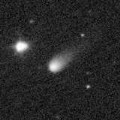
|
Now it is 13.0 mag (Nov. 5, Seiichi Yoshida). It is expected to brighten up to 7 mag in 2017 summer. In the Northern Hemisphere, it keeps observable in good condition until the highlight while the comet will be brightening. In the Southern Hemisphere, it is not observable until early 2017.
Date(TT) R.A. (2000) Decl. Delta r Elong. m1 Best Time(A, h)
Nov. 5 12 28.82 46 0.1 3.405 3.179 68 12.4 4:58 (236, 39)
Nov. 12 12 43.99 45 35.9 3.284 3.112 71 12.2 5:04 (237, 42)
|
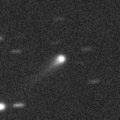
|
It brightened very rapidly and became brighter than expected. Now it is very bright as 12.5 mag (Nov. 1, Chris Wyatt). It will be unobservable in November in the Southern Hemisphere, or in December in the Northern Hemisphere.
Date(TT) R.A. (2000) Decl. Delta r Elong. m1 Best Time(A, h)
Nov. 5 17 24.86 -17 9.9 2.662 1.994 39 12.6 18:28 ( 58, 13)
Nov. 12 17 42.19 -17 1.3 2.709 2.001 36 12.8 18:23 ( 59, 12)
|

|
It brightened up to 6.2 mag in June (June 24, Marco Goiato). Now it is fading. It has already faded down to 13.3 mag (Sept. 28, Chris Wyatt). It it not observable now. In the Southern Hemisphee, it will appear in the morning sky in mid December, then it keeps observable in excellent condition. In the Northern Hemisphere, it will appear in the morning sky in late December, then it keeps low.
Date(TT) R.A. (2000) Decl. Delta r Elong. m1 Best Time(A, h)
Nov. 5 14 47.42 -29 12.1 3.935 2.980 13 12.7 18:28 ( 70,-24)
Nov. 12 14 50.92 -29 33.0 4.012 3.054 12 12.9 5:04 (292,-21)
|
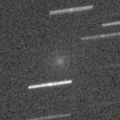
|
It approached to the Sun down to 0.45 a.u. on Oct. 10. It was 12.5-13.0 mag on Sept. 24 (Michael Jager). It will never be observable again in the Northern Hemisphere. In the Southern Hemisphere, it is appearing in the evening sky, but it keeps extremely low after this. It has a very similar orbit to Comet C/1915 R1 ( Mellish ).
Date(TT) R.A. (2000) Decl. Delta r Elong. m1 Best Time(A, h)
Nov. 5 15 55.22 -26 48.5 1.599 0.754 20 13.3 18:28 ( 63,-10)
Nov. 12 16 28.13 -32 39.7 1.699 0.881 23 14.1 18:23 ( 57,-11)
|
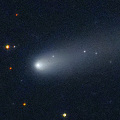
|
Now it is 12.7 mag (Nov. 4, Seiichi Yoshida). It will be getting higher gradually after this, but it will be fading.
Date(TT) R.A. (2000) Decl. Delta r Elong. m1 Best Time(A, h)
Nov. 5 10 52.04 -5 55.4 1.914 1.606 56 13.3 4:58 (306, 32)
Nov. 12 11 6.06 -8 12.5 1.904 1.646 59 13.5 5:04 (312, 33)
|

|
Outburst occured on Oct. 21, and it brightened up to 13.8 mag (Jean-Francois Soulier). It is bright as 12.3 mag still now (Nov. 4, Seiichi Yoshida).
Date(TT) R.A. (2000) Decl. Delta r Elong. m1 Best Time(A, h)
Nov. 5 19 29.30 -23 55.0 6.197 5.891 67 13.7 18:28 ( 30, 25)
Nov. 12 19 33.29 -23 40.1 6.297 5.889 61 13.8 18:23 ( 34, 23)
|

|
It brightened up to 8-9 mag from last winter to spring. Now it is fading. It has already faded down to 12.9 mag (July 23, Chris Wyatt). It is appearing in the morning sky in the Northern Hemisphere. It will be observable in the morning sky in December also in the Southern Hemisphere.
Date(TT) R.A. (2000) Decl. Delta r Elong. m1 Best Time(A, h)
Nov. 5 12 53.38 -3 44.8 4.998 4.160 29 13.8 4:58 (282, 11)
Nov. 12 12 57.55 -4 49.1 4.994 4.218 34 13.8 5:04 (288, 16)
|
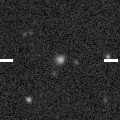
|
It will appear in the morning sky at 13 mag in December. It is expected to brighten up to 7 mag in 2017 spring. But it locates somewhat low at the high light. It was 16.4 mag in August (Aug. 12, Thomas Lehmann), the brightness evolution seemed to have slowed down.
Date(TT) R.A. (2000) Decl. Delta r Elong. m1 Best Time(A, h)
Nov. 5 13 23.28 -11 58.7 3.810 2.892 19 14.0 4:58 (285, 0)
Nov. 12 13 34.03 -12 56.6 3.692 2.812 23 13.8 5:04 (289, 4)
|

|
It brightened up to 11 mag from spring to summer. Now it is not observable. It will be observable at 16 mag again in 2017 spring.
Date(TT) R.A. (2000) Decl. Delta r Elong. m1 Best Time(A, h)
Nov. 5 15 17.61 -16 2.0 2.878 1.904 8 14.0 18:28 ( 78,-11)
Nov. 12 15 35.26 -17 7.5 2.920 1.939 6 14.1 18:23 ( 78,-13)
|
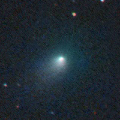
|
Now it is 14.4 mag (Oct. 22, Thomas Lehmann). It will be fading gradually after this. In the Northern Hemisphere, it keeps low after this. In the Southern Hemisphere, it will be getting lower after this, and it will be unobservable in December.
Date(TT) R.A. (2000) Decl. Delta r Elong. m1 Best Time(A, h)
Nov. 5 18 23.12 -30 5.5 2.210 1.790 52 14.0 18:28 ( 39, 12)
Nov. 12 18 44.58 -29 58.6 2.290 1.823 50 14.3 18:23 ( 40, 12)
|
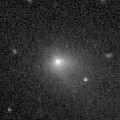
|
Now it is bright as 13.6 mag (Oct. 31, Chris Wyatt). Distant object, but it keeps observable at 13-14 mag for a long time from 2015 to 2016.
Date(TT) R.A. (2000) Decl. Delta r Elong. m1 Best Time(A, h)
Nov. 5 0 34.51 -4 47.6 4.200 5.023 142 14.1 21:34 ( 0, 50)
Nov. 12 0 33.69 -5 3.6 4.282 5.035 135 14.2 21:06 ( 0, 50)
|
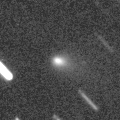
|
It had been lost for a long time over 200 years since its discovery in 1783. It brightened rapidly, and reached up to 13.9 mag in September (Spet. 1, Sandor Szabo). Now it is 14.5 mag (Nov. 4, Seiichi Yoshida). It will be fading after this. It is observable in excellent condition for a while in the Northern Hemisphere. It will be unobservable soon in the Southern Hemisphere.
Date(TT) R.A. (2000) Decl. Delta r Elong. m1 Best Time(A, h)
Nov. 5 5 21.85 38 0.8 1.004 1.865 138 14.2 2:25 (180, 87)
Nov. 12 5 10.97 42 35.3 0.991 1.885 144 14.4 1:47 (180, 83)
|
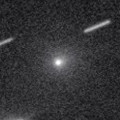
|
Now it is bright as 12.2 mag (Nov. 4, Seiichi Yoshida). It keeps locating extremely low until November in the Southern Hemisphere.
Date(TT) R.A. (2000) Decl. Delta r Elong. m1 Best Time(A, h)
Nov. 5 11 32.77 -0 29.0 2.079 1.611 48 14.3 4:58 (293, 28)
Nov. 12 11 48.78 -2 20.2 2.069 1.647 51 14.5 5:04 (298, 30)
|

|
It keeps unobservable for a long time. It will appear in the morning sky in December, when the comet will be fainter than 15 mag.
Date(TT) R.A. (2000) Decl. Delta r Elong. m1 Best Time(A, h)
Nov. 5 13 30.87 -13 15.9 2.644 1.723 17 14.5 4:58 (285, -2)
Nov. 12 13 49.36 -14 35.7 2.681 1.779 19 14.6 5:04 (288, 0)
|
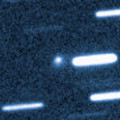
|
Now it is 15.4 mag (Oct. 9, Kunihiro Shima). It will brighten up to 14 mag from winter to spring in 2017, and it will be observable in excellent condition in the Northern Hemisphere. In the Southern Hemisphere, it keeps extremely low until November, and it will be low also around the higlight.
Date(TT) R.A. (2000) Decl. Delta r Elong. m1 Best Time(A, h)
Nov. 5 10 26.96 25 18.6 2.508 2.434 74 14.9 4:58 (276, 56)
Nov. 12 10 39.50 25 2.9 2.426 2.428 78 14.8 5:04 (281, 60)
|
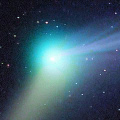
|
It brightened up to 6 mag from last autumn to last winter. Now it is fading. It has already faded down to 15.8 mag (Oct. 24, D. Buczynski). It is observable in good condition in the Northern Hemisphere. It is not observable after this in the Southern Hemisphere.
Date(TT) R.A. (2000) Decl. Delta r Elong. m1 Best Time(A, h)
Nov. 5 4 54.62 57 10.4 4.116 4.831 131 14.9 1:59 (180, 68)
Nov. 12 4 39.78 57 12.1 4.131 4.902 137 15.0 1:16 (180, 68)
|
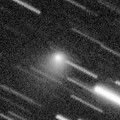
|
It brightened up to 11.6 mag from late August to early September (Aug. 29, Juan Jose Gonzalez). Now it is fading rapidly. It has already faded down to 15.6 mag (Oct. 22, E. Bryssinck). It will be low in November.
Date(TT) R.A. (2000) Decl. Delta r Elong. m1 Best Time(A, h)
Nov. 5 18 44.07 -15 43.9 2.386 2.045 58 14.9 18:28 ( 44, 26)
Nov. 12 18 44.64 -17 23.2 2.553 2.079 51 15.2 18:23 ( 48, 22)
|

|
Now it is 14.6 mag (Oct. 15, Ken-ichi Kadota). It will be fading gradually after this. It will be unobservable soon. But it will appear in the morning sky again at 16 mag in late December in the Northern Hemisphere, or in late January in the Southern Hemisphere.
Date(TT) R.A. (2000) Decl. Delta r Elong. m1 Best Time(A, h)
Nov. 5 16 10.79 5 47.3 4.435 3.620 30 15.1 18:28 ( 88, 12)
Nov. 12 16 16.87 4 25.4 4.513 3.666 27 15.2 18:23 ( 90, 8)
|

|
It has been lost since its discovery in 1978. In 2016, it is expected to return in excellent condition from autumn to winter.
Date(TT) R.A. (2000) Decl. Delta r Elong. m1 Best Time(A, h)
Nov. 5 21 32.98 -22 19.9 0.734 1.289 95 15.1 18:35 ( 0, 33)
Nov. 12 21 55.89 -19 43.8 0.749 1.287 94 15.1 18:30 ( 0, 36)
|
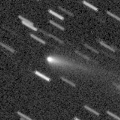
|
Now it is 15.5 mag (Oct. 31, Sandor Szabo). It will be observable at 15-16 mag in good condition from autumn to winter. It locates somewhat low in the Southern Hemisphere.
Date(TT) R.A. (2000) Decl. Delta r Elong. m1 Best Time(A, h)
Nov. 5 4 40.68 34 16.8 1.756 2.645 147 15.1 1:44 ( 0, 89)
Nov. 12 4 36.49 34 28.4 1.736 2.662 154 15.2 1:12 ( 0, 90)
|
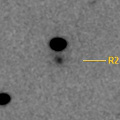
|
Now it is very bright as 15.6 mag (Sept. 11, Hidetaka Sato). It will be observable at 11 mag for a long time from 2017 to 2018. Now it is observable in excellent condition in the Southern Hemisphere. But it keeps low for a while in the Northern Hemisphere.
Date(TT) R.A. (2000) Decl. Delta r Elong. m1 Best Time(A, h)
Nov. 5 3 28.13 -41 38.9 5.297 5.878 121 15.3 0:31 ( 0, 13)
Nov. 12 3 22.77 -41 35.0 5.260 5.827 120 15.3 23:54 ( 0, 13)
|
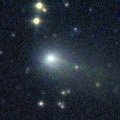
|
It brightened up to 12.5 mag in summer (Aug. 3, Marco Goiato). Now it is fading. It has already faded down to 15.0 mag (Oct. 31, Sandor Szabo). It keeps observable in good condition for a while.
Date(TT) R.A. (2000) Decl. Delta r Elong. m1 Best Time(A, h)
Nov. 5 21 21.73 -16 37.8 2.597 2.857 94 15.5 18:28 ( 2, 38)
Nov. 12 21 28.99 -16 13.5 2.717 2.886 89 15.7 18:23 ( 6, 39)
|
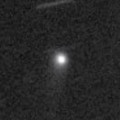
|
Now it is 15.8 mag (Oct. 31, Sandor Szabo). It will brighten up to 14 mag from summer to winter in 2017. Then it will be observable in excellent condition in the Northern Hemisphere. In the Southern Hemisphere, it is hardly observable around the highlight.
Date(TT) R.A. (2000) Decl. Delta r Elong. m1 Best Time(A, h)
Nov. 5 22 58.25 -13 34.0 3.799 4.348 117 15.8 19:58 ( 0, 42)
Nov. 12 22 54.45 -12 41.6 3.863 4.306 110 15.8 19:27 ( 0, 42)
|
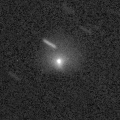
|
It has brightened in outburst up to 14 mag twice, in 2006 January and 2011 May. Third outburst occured on Aug. 28, and it brightened up to 14.8 mag (Aug. 30, Juan Jose Gonzalez). It has already faded down to 17.2 mag (Oct. 19, Kunihiro Shima). It is observable in good condition for a while.
Date(TT) R.A. (2000) Decl. Delta r Elong. m1 Best Time(A, h)
Nov. 5 1 6.27 4 30.8 5.489 6.396 154 15.8 22:06 ( 0, 60)
Nov. 12 1 4.39 4 18.3 5.560 6.409 146 15.9 21:36 ( 0, 59)
|
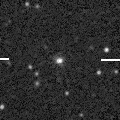
|
Now it is 16.5 mag (Oct. 22, E. Bryssinck). It will brighten up to 15 mag in winter. But it will be getting lower gradually after autumn.
Date(TT) R.A. (2000) Decl. Delta r Elong. m1 Best Time(A, h)
Nov. 5 21 58.41 -7 13.3 1.550 2.062 106 15.9 18:59 ( 0, 48)
Nov. 12 22 3.15 -6 15.9 1.591 2.025 100 15.8 18:36 ( 0, 49)
|

|
It will approach to the earth down to 0.08 a.u. to the earth in mid February, and it is expected to be observable at 6 mag in good condition. Now it is 18.4 mag (Nov. 6, Martin Masek). It will brighten rapidly after this, but it keeps very low in the evening sky for a while. It will be unobservable temporarily in January. Then it keeps observable in good condition after mid February.
Date(TT) R.A. (2000) Decl. Delta r Elong. m1 Best Time(A, h)
Nov. 5 18 12.01 -25 39.7 1.543 1.181 49 16.8 18:28 ( 44, 14)
Nov. 12 18 28.22 -25 37.0 1.488 1.082 46 15.9 18:23 ( 45, 13)
|
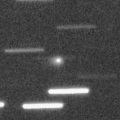
|
Now it is 15.7 mag (Oct. 31, Sandor Szabo). It will brighten up to 13 mag and will be observable in good condition in 2017 summer. In 2016, it keeps observable until winter when it will brighten up to 15.5 mag. It locates somewhat low in the Southern Hemisphere.
Date(TT) R.A. (2000) Decl. Delta r Elong. m1 Best Time(A, h)
Nov. 5 1 43.90 28 6.9 3.076 4.030 161 16.0 22:42 ( 0, 83)
Nov. 12 1 29.01 26 49.2 3.062 3.982 155 15.9 22:00 ( 0, 82)
|
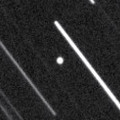
|
Now it is 14.9 mag (Sept. 29, Sandor Szabo). In the Northern Hemisphere, it keeps observable in excellent condition, but it will be fading after this. It keeps locating very low in the Southern Hemisphere.
Date(TT) R.A. (2000) Decl. Delta r Elong. m1 Best Time(A, h)
Nov. 5 22 37.82 37 46.8 0.739 1.522 122 16.0 19:38 (180, 87)
Nov. 12 22 47.28 32 47.3 0.855 1.597 119 16.3 19:20 ( 0, 88)
|
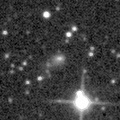
|
Now it is 16.8 mag (Oct. 20, Kunihiro Shima). It will be observable at 13 mag for a long time from 2017 to 2018. It will be unobservable temporarily in early November in the Southern Hemisphere, or in early December in the Northern Hemisphere.
Date(TT) R.A. (2000) Decl. Delta r Elong. m1 Best Time(A, h)
Nov. 5 18 31.83 -8 17.8 5.973 5.491 56 16.1 18:28 ( 52, 30)
Nov. 12 18 32.97 -8 5.6 6.028 5.450 50 16.1 18:23 ( 57, 27)
|

|
It will brighten up to 12 mag from winter to spring. In the Northern Hemisphere, it keeps observable while the comet is brightening gradually. But it will be unobservable in late February. In the Southern Hemisphere, it keeps unobservable until December. But it keeps observable for a long time after late December.
Date(TT) R.A. (2000) Decl. Delta r Elong. m1 Best Time(A, h)
Nov. 5 12 31.91 5 31.8 2.606 1.930 38 16.5 4:58 (278, 20)
Nov. 12 12 47.73 3 51.9 2.496 1.866 41 16.2 5:04 (282, 23)
|
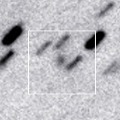
|
Now it is 17.2 mag (Oct. 22, C. Bell). It keeps 16-17 mag for a long time from 2016 to 2019. It keeps locating near by the equator.
Date(TT) R.A. (2000) Decl. Delta r Elong. m1 Best Time(A, h)
Nov. 5 9 19.60 1 55.3 9.811 9.711 81 16.2 4:58 (325, 52)
Nov. 12 9 20.90 1 47.8 9.691 9.704 87 16.2 5:04 (337, 55)
|
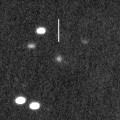
|
Now it is 17.0 mag (Oct. 25, D. Buczynski). It will be observable at 16 mag in good condition from autumn to winter. It locates low in the Southern Hemisphere.
Date(TT) R.A. (2000) Decl. Delta r Elong. m1 Best Time(A, h)
Nov. 5 7 31.72 24 23.9 3.359 3.841 111 16.3 4:34 ( 0, 79)
Nov. 12 7 32.57 24 34.0 3.256 3.833 118 16.2 4:08 ( 0, 80)
|
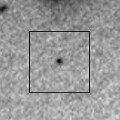
|
First return of a new periodic comet discovered in 2007. Now it is 19.4 mag (Sept. 1, K. Sarneczky, P. Szekely). It was expected to brighten up to 16.5 mag and will be observable in good condition from autumn to winter. But actually, it is fainter than predicted by 3 mag.
Date(TT) R.A. (2000) Decl. Delta r Elong. m1 Best Time(A, h)
Nov. 5 3 29.99 -13 53.6 1.471 2.371 148 16.6 0:33 ( 0, 41)
Nov. 12 3 24.54 -13 37.3 1.451 2.352 148 16.5 0:00 ( 0, 41)
|
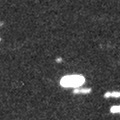
|
Now it is 16.5 mag (Oct. 24, D. Buczynski). It will brighten up to 15 mag and will be observable in good condition from autum to winter in 2017. In the Northern Hemisphere, it keeps observable in good condition for a long time while the comet will be brightening. It is not observable until 2017 summer in the Southern Hemisphere.
Date(TT) R.A. (2000) Decl. Delta r Elong. m1 Best Time(A, h)
Nov. 5 3 53.30 59 33.9 4.669 5.407 134 16.7 0:58 (180, 65)
Nov. 12 3 37.34 59 2.4 4.594 5.374 138 16.6 0:14 (180, 66)
|
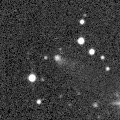
|
It brightened rapidly. Now it is 16.9 mag (Oct. 4, Mt. Lemmon Survey). It is observable at 16.5 mag in good condition from autumn to winter.
Date(TT) R.A. (2000) Decl. Delta r Elong. m1 Best Time(A, h)
Nov. 5 22 35.54 -9 25.3 2.098 2.663 114 16.6 19:36 ( 0, 46)
Nov. 12 22 38.24 -8 41.2 2.171 2.650 108 16.6 19:11 ( 0, 46)
|
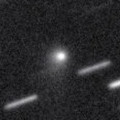
|
It brightened up to 15 mag in early 2016. Now it is fading. It has already faded down to 17.0 mag (Oct. 9, P. Carson). In the Northern Hemisphere, it keeps observable in good condition for a long time until 2017 autumn when the comet will be fainter than 18 mag. It will never be observable after this in the Southern Hemisphere.
Date(TT) R.A. (2000) Decl. Delta r Elong. m1 Best Time(A, h)
Nov. 5 13 46.45 66 27.8 6.006 5.963 82 16.6 4:58 (208, 33)
Nov. 12 13 59.17 66 11.3 5.995 5.989 84 16.7 5:04 (209, 35)
|

|
Now it is 17.8 mag (Sept. 24, Kunihiro Shima). It will be getting higher after this, and it will be observable at 17 mag in good condition in winter.
Date(TT) R.A. (2000) Decl. Delta r Elong. m1 Best Time(A, h)
Nov. 5 11 19.31 3 55.9 2.705 2.263 53 16.7 4:58 (292, 34)
Nov. 12 11 30.77 3 0.4 2.659 2.288 57 16.8 5:04 (297, 37)
|
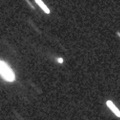
|
Now it is 16.7 mag (Oct. 3, A. Diepvens). It brightened rapidly, and became brighter than originally expected. It keeps 17 mag until 2017. In the Northern Hemisphere, it keeps observable in excellent condition for a long time. It is not observable in the Southern Hemisphere.
Date(TT) R.A. (2000) Decl. Delta r Elong. m1 Best Time(A, h)
Nov. 5 13 34.82 54 25.5 7.551 7.297 71 16.9 4:58 (222, 31)
Nov. 12 13 37.63 54 19.2 7.501 7.301 74 16.9 5:04 (224, 35)
|
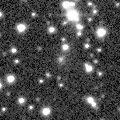
|
It will pass the perihelion in 2019. However, it has not been brightening since the discovery in 2010. Now it is 17.7 mag (Oct. 24, D. Buczynski). It keeps observable in excellent condition in the Northern Hemisphere. It is not observable in the Southern Hemisphere.
Date(TT) R.A. (2000) Decl. Delta r Elong. m1 Best Time(A, h)
Nov. 5 4 30.52 60 56.6 9.103 9.778 130 17.2 1:34 (180, 64)
Nov. 12 4 26.23 61 18.4 9.041 9.758 134 17.2 1:03 (180, 64)
|
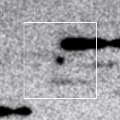
|
Appearing in the morning sky. It keeps 16 mag for a long time from 2017 to 2018.
Date(TT) R.A. (2000) Decl. Delta r Elong. m1 Best Time(A, h)
Nov. 5 9 49.93 -12 22.2 6.291 6.032 70 17.3 4:58 (325, 35)
Nov. 12 9 49.96 -12 19.8 6.157 6.008 76 17.2 5:04 (334, 39)
|
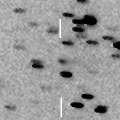
|
Now it is 17.2 mag (Oct. 25, D. Buczynski). In the Northern Hemisphere, it will be observable at 17 mag in excellent condition in winter. It locates low in the Southern Hemisphere.
Date(TT) R.A. (2000) Decl. Delta r Elong. m1 Best Time(A, h)
Nov. 5 7 18.01 32 45.8 2.835 3.386 115 17.4 4:21 ( 0, 88)
Nov. 12 7 19.86 33 3.1 2.754 3.387 122 17.3 3:55 ( 0, 88)
|
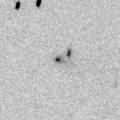
|
Now it is 17.2 mag (Oct. 21, Mt. Lemmon Survey). It tends to be brightest after the perihelion passage. It is observable at 17.5 mag in good condition from autumn to winter.
Date(TT) R.A. (2000) Decl. Delta r Elong. m1 Best Time(A, h)
Nov. 5 2 20.36 -0 15.5 2.132 3.095 163 17.3 23:19 ( 0, 55)
Nov. 12 2 16.12 -0 31.0 2.167 3.105 157 17.4 22:48 ( 0, 55)
|
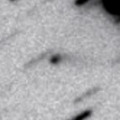
|
It was observed at 17 mag last winter. It will be observable at 17 mag again next winter. Now it is 18.1 mag (Sept. 24, Kunihiro Shima). It is observable in good condition in the Northern Hemisphere. But it locates low in the Southern Hemisphere.
Date(TT) R.A. (2000) Decl. Delta r Elong. m1 Best Time(A, h)
Nov. 5 10 46.33 14 2.3 4.094 3.787 65 17.3 4:58 (288, 46)
Nov. 12 10 52.93 14 39.8 4.007 3.802 71 17.3 5:04 (293, 52)
|
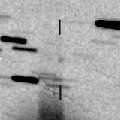
|
First return of a new periodic comet discovered in 2005. Now it is 18.2 mag (Oct. 24, D. Buczynski). In the Northern Hemisphere, it will be observable at 17 mag in excellent condition in winter. It locates somewhat low in the Southern Hemisphere.
Date(TT) R.A. (2000) Decl. Delta r Elong. m1 Best Time(A, h)
Nov. 5 3 53.04 23 36.0 1.863 2.821 161 17.4 0:56 ( 0, 79)
Nov. 12 3 48.76 23 17.6 1.843 2.822 169 17.3 0:25 ( 0, 78)
|
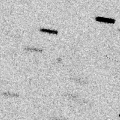
|
Now it is 18.4 mag (Oct. 9, Kunihiro Shima). In the Northern Hemisphere, it is observable at 17.5 mag in excellent condition from autumn to winter. It keeps extremely low in the Southern Hemisphere.
Date(TT) R.A. (2000) Decl. Delta r Elong. m1 Best Time(A, h)
Nov. 5 9 45.89 31 40.8 2.095 2.239 85 17.4 4:58 (271, 67)
Nov. 12 9 58.29 32 9.3 2.034 2.254 89 17.3 5:04 (273, 71)
|
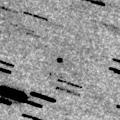
|
Now it is 17.7 mag (Oct. 22, D. Buczynski). It will pass the perihelion on Mar. 10, 2017. In the Northern Hemisphere, it keeps observable in the evening sky until late February while the comet will be brightening up to 8.5 mag. In the Southern Hemisphere, it will appear in the morning sky in late March at 8 mag, then it keeps observable while the comet will be fading.
Date(TT) R.A. (2000) Decl. Delta r Elong. m1 Best Time(A, h)
Nov. 5 23 15.83 8 36.3 1.304 2.080 129 17.4 20:15 ( 0, 64)
Nov. 12 23 7.00 7 23.5 1.317 2.006 120 17.5 19:39 ( 0, 62)
|
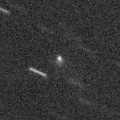
|
Now it is 17.7 mag (Oct. 20, J.-F. Soulier, C. Rinner, F. Kugel, J. Nicolas). It will be observable at 17.5 mag in good condition in autumn.
Date(TT) R.A. (2000) Decl. Delta r Elong. m1 Best Time(A, h)
Nov. 5 22 53.57 0 56.8 1.714 2.392 121 17.5 19:54 ( 0, 56)
Nov. 12 22 57.25 0 54.8 1.769 2.375 115 17.5 19:30 ( 0, 56)
|
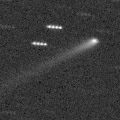
|
It brightened up to 15 mag from late 2014 to early 2016. Now it is fading slowly. Now it is 17.1 mag (Oct. 23, C. Bell). In the Northern Hemisphere, it will be observable at 16-17 mag in autumn in good condition. It locates extremely low in the Southern Hemisphere.
Date(TT) R.A. (2000) Decl. Delta r Elong. m1 Best Time(A, h)
Nov. 5 21 25.80 36 50.8 5.059 5.449 108 17.5 18:28 (167, 88)
Nov. 12 21 22.50 35 51.8 5.180 5.485 102 17.6 18:23 (101, 84)
|
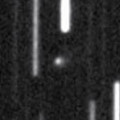
|
Now it is 17.7 mag (Oct. 22, CAO, San Pedro de Atacama). It keeps 17 mag for a long time from 2016 autumn to 2017 summer, and it keeps observable good condition all through that period in the Southern Hemisphere. In the Northern Hemisphere, it will never be observable again after this.
Date(TT) R.A. (2000) Decl. Delta r Elong. m1 Best Time(A, h)
Nov. 5 4 27.96 -52 22.4 2.234 2.712 108 17.6 1:31 ( 0, 3)
Nov. 12 4 13.93 -55 50.3 2.249 2.684 105 17.5 0:50 ( 0, -1)
|

|
Now it is 17.3 mag (Oct. 24, D. Buczynski). It keeps observable at 17.5 mag in good condition from autumn to winter.
Date(TT) R.A. (2000) Decl. Delta r Elong. m1 Best Time(A, h)
Nov. 5 3 30.30 17 7.9 2.101 3.078 168 17.7 0:34 ( 0, 72)
Nov. 12 3 25.81 16 41.2 2.086 3.074 175 17.6 0:02 ( 0, 72)
|

|
Peculiar asteroid with a comet-like orbit. It is observable at 18 mag in good condition in October.
Date(TT) R.A. (2000) Decl. Delta r Elong. m1 Best Time(A, h)
Nov. 5 2 17.31 -20 29.3 2.054 2.911 143 17.9 23:16 ( 0, 34)
Nov. 12 2 4.76 -23 33.1 2.124 2.917 135 18.0 22:36 ( 0, 31)
|
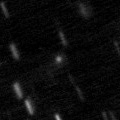
|
Now it is 17.8 mag (Oct. 15, J. Oey, P. Camilleri, H. Williams). It keeps 17 mag for a long time in 2016, and it will be observable in excellent condition in the Southern Hemisphere. It is hardly observable in the Northern Hemisphere.
Date(TT) R.A. (2000) Decl. Delta r Elong. m1 Best Time(A, h)
Nov. 5 23 51.82 -46 25.5 3.358 3.771 107 17.9 20:51 ( 0, 9)
Nov. 12 23 40.63 -44 32.0 3.473 3.800 101 18.0 20:12 ( 0, 11)
|
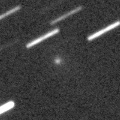
|
First return of a new periodic comet which brightened up to 16.5 mag in 2008. The condition of this apparition is very good. It was expected to brighten up to 15.5 mag in autumn and will be observable in good condition. But actually, it is 17.8 mag (Oct. 22, E. Bryssinck), fainter than originally expected by 2-3 mag.
Date(TT) R.A. (2000) Decl. Delta r Elong. m1 Best Time(A, h)
Nov. 5 23 17.85 -5 20.3 1.584 2.305 125 18.1 20:18 ( 0, 50)
Nov. 12 23 17.60 -3 48.8 1.655 2.303 118 18.2 19:50 ( 0, 51)
|
|
![]()
 56P/Slaughter-Burnham
56P/Slaughter-Burnham C/2016 R2 ( PanSTARRS )
C/2016 R2 ( PanSTARRS ) 53P/Van Biesbroeck
53P/Van Biesbroeck C/2016 N4 ( MASTER )
C/2016 N4 ( MASTER ) 174P/(60558) 2000 EC98 ( Echeclus )
174P/(60558) 2000 EC98 ( Echeclus ) 93P/Lovas 1
93P/Lovas 1 45P/Honda-Mrkos-Pajdusakova
45P/Honda-Mrkos-Pajdusakova C/2015 VL62 ( Lemmon-Yeung-PanSTARRS )
C/2015 VL62 ( Lemmon-Yeung-PanSTARRS ) (3200) Phaethon
(3200) Phaethon C/2015 O1 ( PanSTARRS )
C/2015 O1 ( PanSTARRS ) 73P/Schwassmann-Wachmann 3
73P/Schwassmann-Wachmann 3 C/2014 B1 ( Schwartz )
C/2014 B1 ( Schwartz ) 74P/Smirnova-Chernykh
74P/Smirnova-Chernykh P/2016 R1 ( Catalina )
P/2016 R1 ( Catalina ) C/2015 V1 ( PanSTARRS )
C/2015 V1 ( PanSTARRS ) 188P/LINEAR-Mueller
188P/LINEAR-Mueller C/2013 V4 ( Catalina )
C/2013 V4 ( Catalina ) 118P/Shoemaker-Levy 4
118P/Shoemaker-Levy 4 C/2014 R3 ( PanSTARRS )
C/2014 R3 ( PanSTARRS ) C/2010 U3 ( Boattini )
C/2010 U3 ( Boattini ) C/2016 A1 ( PanSTARRS )
C/2016 A1 ( PanSTARRS ) P/2015 TP200 ( LINEAR )
P/2015 TP200 ( LINEAR ) 136P/Mueller 3
136P/Mueller 3 C/2015 X7 ( ATLAS )
C/2015 X7 ( ATLAS ) P/2016 Q1 ( Read )
P/2016 Q1 ( Read ) 33P/Daniel
33P/Daniel 2P/Encke
2P/Encke 343P/2016 P3 ( NEAT-LONEOS )
343P/2016 P3 ( NEAT-LONEOS ) C/2014 A4 ( SONEAR )
C/2014 A4 ( SONEAR ) C/2016 S1 ( PanSTARRS )
C/2016 S1 ( PanSTARRS ) 128P/Shoemaker-Holt 1
128P/Shoemaker-Holt 1 2016 PN66
2016 PN66 C/2015 B2 ( PanSTARRS )
C/2015 B2 ( PanSTARRS ) 338P/2016 N1 ( McNaught )
338P/2016 N1 ( McNaught )![]()















































